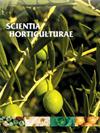The balance between lignin and flavonoid metabolism has a central role in the changes of quality in young shoots of the tea plant (Camellia sinensis)
IF 3.9
2区 农林科学
Q1 HORTICULTURE
引用次数: 0
Abstract
Tenderness is a core index for evaluating the quality of young tea plant shoots and ultimately influences the quality and yield of tea products in terms of bioactive components, processing adaptability, tenderness-keeping ability, and other factors. In this study, we describe the underlying regulatory mechanism of tenderness changes in young shoots of tea plants, combined with biochemical composition determination and transcriptome analysis. The high accumulation of lignin, cellulose, hemicellulose, and pectin is a direct factor leading to a decrease in the tenderness of young shoots, which is dependent on the upregulated expression of genes encoding enzymes related to their biosynthesis. The accumulation of lignin during tenderness decrease in young shoots was accompanied by a decrease in the major flavonoid catechins and anthocyanins, and the upregulated expression of lignin biosynthesis-related genes was also accompanied by the downregulated expression of flavonoid biosynthesis-related genes, implying that the competition between the lignin and flavonoid biosynthesis pathways influences tenderness and bioactive component changes in young tea plant shoots. In addition, as core factors, hydroxycinnamoyl-CoA: shikimate/quinate hydroxycinnamoyl transferase (HCT) and chalcone synthase (CHS) synergize with downstream enzymes to maintain the balance between lignin and flavonoid metabolism. MYB transcription factors in the G10 and G11 groups regulated the expression of genes related to lignin and flavonoid biosynthesis pathways, respectively, and other transcription factors may also play roles in regulating this balance. This study elucidates the regulatory mechanisms of quality changes in young tea plant shoots from the perspective of tenderness.木质素和类黄酮代谢之间的平衡在茶树(Camellia sinensis)幼芽的品质变化中起着核心作用
嫩度是评价茶树幼芽品质的核心指标,最终影响茶叶产品的生物活性成分、加工适应性、保嫩能力等品质和产量。本研究结合生化成分测定和转录组分析,阐述了茶树幼芽嫩度变化的内在调控机制。木质素、纤维素、半纤维素和果胶的大量积累是导致嫩芽嫩度下降的直接因素,而嫩芽嫩度的下降取决于编码这些物质生物合成相关酶的基因表达的上调。嫩芽嫩度下降过程中木质素的积累伴随着主要类黄酮儿茶素和花青素的减少,木质素生物合成相关基因的表达上调也伴随着类黄酮生物合成相关基因的表达下调,这意味着木质素和类黄酮生物合成途径之间的竞争影响着茶树嫩芽的嫩度和生物活性成分的变化。此外,作为核心因子,羟基肉桂酰-CoA:莽草酸/醌羟基肉桂酰转移酶(HCT)和查尔酮合成酶(CHS)与下游酶协同作用,维持木质素和类黄酮代谢之间的平衡。G10 和 G11 组的 MYB 转录因子分别调控木质素和类黄酮生物合成途径相关基因的表达,其他转录因子也可能在调控这种平衡中发挥作用。本研究从嫩度的角度阐明了茶树幼芽品质变化的调控机制。
本文章由计算机程序翻译,如有差异,请以英文原文为准。
求助全文
约1分钟内获得全文
求助全文
来源期刊

Scientia Horticulturae
农林科学-园艺
CiteScore
8.60
自引率
4.70%
发文量
796
审稿时长
47 days
期刊介绍:
Scientia Horticulturae is an international journal publishing research related to horticultural crops. Articles in the journal deal with open or protected production of vegetables, fruits, edible fungi and ornamentals under temperate, subtropical and tropical conditions. Papers in related areas (biochemistry, micropropagation, soil science, plant breeding, plant physiology, phytopathology, etc.) are considered, if they contain information of direct significance to horticulture. Papers on the technical aspects of horticulture (engineering, crop processing, storage, transport etc.) are accepted for publication only if they relate directly to the living product. In the case of plantation crops, those yielding a product that may be used fresh (e.g. tropical vegetables, citrus, bananas, and other fruits) will be considered, while those papers describing the processing of the product (e.g. rubber, tobacco, and quinine) will not. The scope of the journal includes all horticultural crops but does not include speciality crops such as, medicinal crops or forestry crops, such as bamboo. Basic molecular studies without any direct application in horticulture will not be considered for this journal.
 求助内容:
求助内容: 应助结果提醒方式:
应助结果提醒方式:


